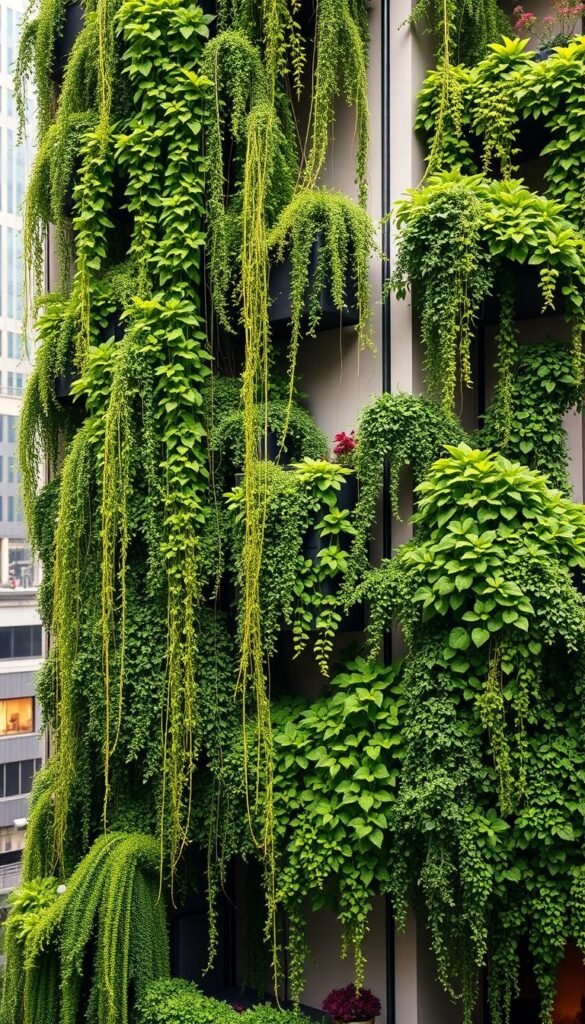City living doesn’t mean you have to give up greenery. If you’re struggling with cramped patios or tiny balconies, there’s a smart solution that lets you grow lush plants without sacrificing precious square footage. Vertical gardening turns walls, railings, and even old shelves into vibrant green spaces, proving you don’t need a backyard to enjoy nature’s benefits.
This approach goes beyond just saving room. By stacking plants upward, you’ll create living art that cleans the air and cools your home naturally. Studies show these setups filter pollutants while lowering indoor temperatures – perfect for beating summer heat in apartments. Plus, caring for your green wall can reduce stress by nearly a third!
You’ll love how easy it is to transform blank walls or empty corners. From herbs to flowers, vertical arrangements let you grow more in less space. Check out these creative vertical gardening ideas that turn overlooked areas into eye-catching displays. Even better? These gardens support bees and butterflies, making your home part of your neighborhood’s ecosystem.
Ready to rethink what’s possible? We’ll show you how to build gardens that work as hard as you do – improving air quality, boosting curb appeal, and creating peaceful retreats in the busiest cities.
Understanding the Basics of Vertical Gardening
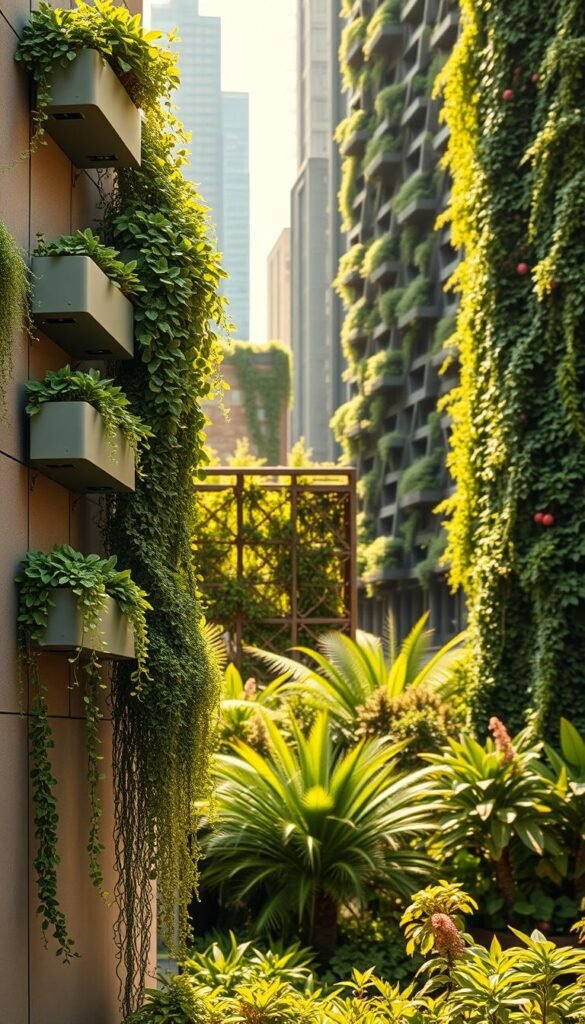
Transforming blank walls into thriving plant displays begins with one simple shift—growing upward instead of outward. This method lets you turn unused vertical surfaces into productive green zones, perfect for balconies or tight corners where traditional gardens won’t fit.
What Is Vertical Gardening?
Vertical gardening uses structures like trellises, hanging pockets, or stacked planters to grow plants in layers. Instead of spreading roots across the ground, vines climb and trailing varieties spill downward. Even herbs and vegetables thrive in these setups—think cherry tomatoes winding up a metal grid or mint cascading from wall-mounted pots.
The Benefits of Growing Upward in Urban Areas
City dwellers gain big advantages with this approach. “You’re not just saving space—you’re creating a living filter,” notes a landscape designer. Vertical systems use targeted watering to reduce waste, while leafy covers shield lower plants from harsh sun. They also soften concrete views, adding natural beauty where it’s needed most.
These gardens excel in small footprints. A single tower can hold 20+ plants—ideal for growing salad greens or flowers. Want to start small? Explore urban gardening basics to build confidence before tackling larger projects.
Choosing the Right Structures and Plants
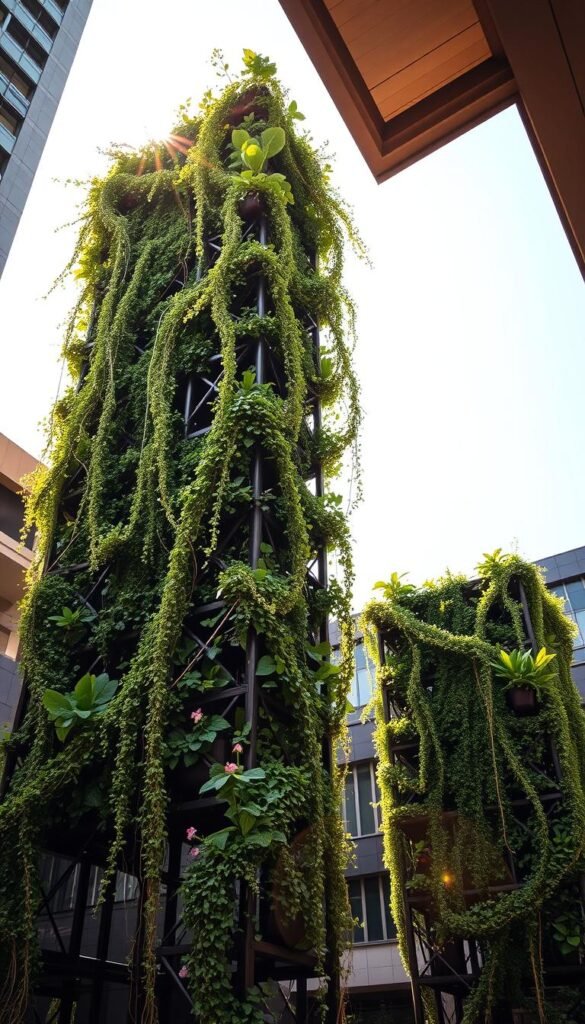
Your vertical garden’s success hinges on matching durable frameworks to plants that thrive in your space. Start by evaluating your available walls or railings – even narrow strips can host vibrant growth when paired with smart solutions.
Selecting Vertical Garden Structures: Trellises, Living Walls, and More
Trellises made of metal or cedar wood offer classic support for climbing varieties. For concrete surfaces, living wall panels with built-in pockets turn blank spaces into instant gardens. “Modular systems let you start small and expand over time,” advises a rooftop gardener we interviewed.
Consider tower planters for herbs and leafy greens – their stacked design fits perfectly on balconies. If you’re working with overhead space, hanging baskets add depth while keeping walkways clear. Always choose UV-resistant materials that withstand your local weather patterns.
Ideal Plant Choices: Climbing, Edible, and Trailing Varieties
Pair structures with plants that match their purpose. Metal grids excel with cherry tomatoes or passionflowers, while wooden lattices support jasmine’s fragrant climb. For compact spaces, try thyme or oregano in pocket planters – they’ll flavor your meals while smelling amazing.
Trailing succulents like string of pearls bring texture to shaded walls, while ivy creates cooling green curtains. In sunny spots, mix edible flowers like nasturtiums with practical peppers. Remember: lightweight plants prevent overloading your structures.
Maximizing Urban Spaces with Vertical Garden Design Techniques
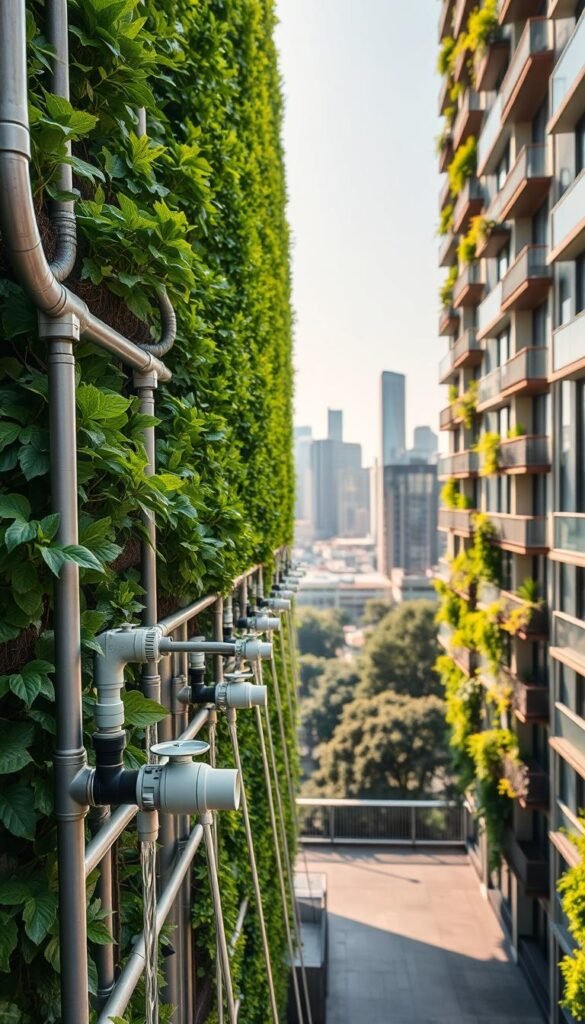
Turn your cramped balcony into a thriving green oasis by mastering two key elements: intelligent layout planning and water management. These factors determine whether your plants merely survive or truly flourish in their vertical home.
Planning Your Layout for Maximum Impact
Start by mapping sunlight patterns across your space. South-facing walls get intense light, while north-facing areas suit shade lovers. Track how shadows move throughout the day using a sunlight calculator app – this helps match plants to their ideal spots.
| Plant Type | Ideal Position | Key Benefit |
|---|---|---|
| Tall varieties (sunflowers) | Top shelves | Maximizes light absorption |
| Trailing plants (ivy) | Lower tiers | Creates visual flow |
| Herbs (basil) | Mid-level pockets | Easy harvesting access |
Mix textures and colors for eye-catching displays. Pair spiky succulents with soft ferns, or contrast purple basil against golden creeping Jenny. Leave 4-6 inches between plants for air flow – overcrowding invites disease.
Incorporating Irrigation Systems and Water Efficiency
Vertical gardens dry out faster than traditional beds. “Gravity pulls water downward, leaving upper plants thirsty,” explains a horticulturist from DREarth’s urban gardening team. Solve this with:
- Self-watering planters: Reservoirs supply roots for 3-5 days
- Capillary mats: Wicks moisture evenly across tiers
- Drip irrigation: Timed systems deliver precise amounts
For large installations, zone your watering. Group moisture-loving ferns separately from drought-tolerant sedums. Consider space-saving irrigation racks that integrate directly into vertical structures. Always use soil mixed with water-retaining crystals – they reduce watering frequency by 40%.
Effective Care, Maintenance, and Seasonal Adjustments
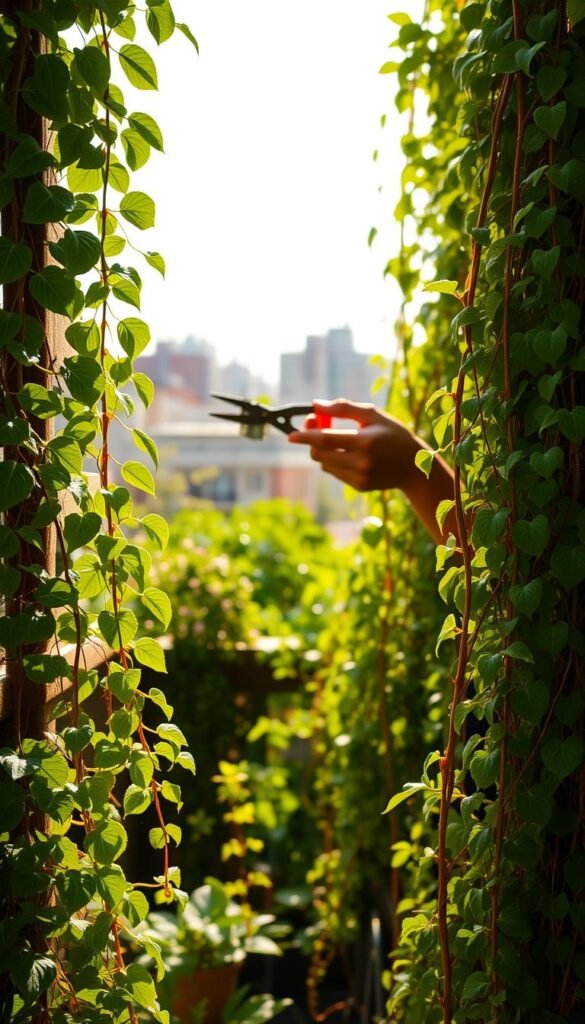
Keeping your vertical setup healthy requires smart routines tailored to its unique needs. Unlike traditional gardens, these upward-growing systems demand special attention to watering patterns, soil quality, and seasonal shifts. Let’s break down how to keep your plants vibrant through every weather change.
Watering, Fertilizing, and Pest Management Tips
Water vertical gardens slowly from the top, letting moisture trickle down naturally. Drainage holes are essential – they prevent soggy roots while ensuring even distribution. For busy plant lovers, drip irrigation systems cut watering time by half while keeping soil consistently damp.
Since vertical planters hold less soil, nutrients vanish faster. Mix slow-release fertilizer pellets into potting mix every spring, and add compost monthly during growing seasons. Spot aphids or mites? Spray leaves with diluted neem oil or introduce ladybugs – nature’s pest control squad.
Adapting Your Garden for Seasonal Changes
When temperatures drop, move tender herbs like basil indoors. Protect outdoor setups with frost cloth draped over frames. Reduce watering to once weekly in winter, but check soil moisture first – overwatering kills more plants than cold snaps.
| Season | Key Tasks | Plant Focus |
|---|---|---|
| Spring | Refresh soil, start fertilizing | New seedlings |
| Summer | Daily water checks, pest patrols | Heat-loving blooms |
| Fall | Trim overgrowth, add mulch | Cold-hardy greens |
Rotate plants yearly to prevent disease buildup. For year-round color, swap summer petunias for winter pansies in movable containers. Remember: healthy gardens adapt as gracefully as nature itself.
Bringing Your Vertical Garden Vision to Life
Unlock the potential of every wall and corner through smart vertical gardening. Imagine honeysuckle vines weaving through a privacy screen that hides traffic views while perfuming your balcony. Or pluck fresh strawberries from a living wall near your kitchen window – edible gardens make meals tastier and grocery trips shorter.
Indoor spaces thrive too. Mount pocket planters in bathrooms for air-purifying ferns or grow basil above your sink. These compact “green accents” boost moods and air quality without cluttering counters. Rotate seasonal blooms like pansies in fall and petunias in summer for year-round color shifts.
Start small with a weekend project: repurpose wooden pallets into herb towers or hang metal grids for climbing cherry tomatoes. For ambitious creators, modular living wall systems let you expand gradually. Every setup teaches valuable lessons about light patterns and plant needs.
Your vertical journey transforms blank surfaces into dynamic ecosystems. Whether crafting a floral masterpiece or growing salad greens, these gardens prove no space is too tight for nature’s beauty and benefits. Ready to see your walls differently?

